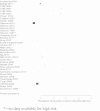A systematic review of the prevalence of parental concerns measured by the Parents' Evaluation of Developmental Status (PEDS) indicating developmental risk
- PMID: 25218133
- PMCID: PMC4175611
- DOI: 10.1186/1471-2431-14-231
A systematic review of the prevalence of parental concerns measured by the Parents' Evaluation of Developmental Status (PEDS) indicating developmental risk
Abstract
Background: Parental concerns about their children's development can be used as an indicator of developmental risk. We undertook a systematic review of the prevalence of parents' concerns as an indicator of developmental risk, measured by the Parents' Evaluation of Developmental Status (PEDS) and associated risk factors.
Methods: Electronic databases, bibliographies and websites were searched and experts contacted. Studies were screened for eligibility and study characteristics were extracted independently by two authors. A summary estimate for prevalence was derived. Meta-regression examined the impact of study characteristics and quality. Meta-analysis was used to derive pooled estimates of the impact of biological and psychosocial risk factors on the odds of parental concerns indicating high developmental risk.
Results: Thirty seven studies were identified with a total of 210,242 subjects. Overall 13.8% (95% CI 10.9 -16.8%) of parents had concerns indicating their child was at high developmental risk and 19.8% (95% CI 16.7-22.9%) had concerns indicating their child was at moderate developmental risk. Male gender, low birth weight, poor/fair child health rating, poor maternal mental health, lower socioeconomic status (SES), minority ethnicity, not being read to, a lack of access to health care and not having health insurance were significantly associated with parental concerns indicating a high developmental risk.
Conclusions: The prevalence of parental concerns measured with the PEDS indicating developmental risk is substantial. There is increased prevalence associated with biological and psychosocial adversity.
Trial registration: PROSPERO Registration: CRD42012003215.
Figures
Similar articles
-
Face-to-face interventions for informing or educating parents about early childhood vaccination.Cochrane Database Syst Rev. 2018 May 8;5(5):CD010038. doi: 10.1002/14651858.CD010038.pub3. Cochrane Database Syst Rev. 2018. PMID: 29736980 Free PMC article.
-
Falls prevention interventions for community-dwelling older adults: systematic review and meta-analysis of benefits, harms, and patient values and preferences.Syst Rev. 2024 Nov 26;13(1):289. doi: 10.1186/s13643-024-02681-3. Syst Rev. 2024. PMID: 39593159 Free PMC article.
-
Parent training interventions for Attention Deficit Hyperactivity Disorder (ADHD) in children aged 5 to 18 years.Cochrane Database Syst Rev. 2011 Dec 7;2011(12):CD003018. doi: 10.1002/14651858.CD003018.pub3. Cochrane Database Syst Rev. 2011. PMID: 22161373 Free PMC article.
-
Parent training interventions for parents with intellectual disability.Cochrane Database Syst Rev. 2018 Jul 13;7(7):CD007987. doi: 10.1002/14651858.CD007987.pub3. Cochrane Database Syst Rev. 2018. PMID: 30004571 Free PMC article.
-
Welfare-to-work interventions and their effects on the mental and physical health of lone parents and their children.Cochrane Database Syst Rev. 2018 Feb 26;2(2):CD009820. doi: 10.1002/14651858.CD009820.pub3. Cochrane Database Syst Rev. 2018. PMID: 29480555 Free PMC article.
Cited by
-
Parent concerns for child development following admission to neonatal intensive or special care: From birth to adolescence.J Paediatr Child Health. 2022 Sep;58(9):1539-1547. doi: 10.1111/jpc.16030. Epub 2022 Jun 4. J Paediatr Child Health. 2022. PMID: 35661453 Free PMC article.
-
Evaluating the "right@home" randomized trial of nurse home visiting using linked administrative data at school transition.Int J Popul Data Sci. 2024 May 16;9(2):2400. doi: 10.23889/ijpds.v9i2.2400. eCollection 2024. Int J Popul Data Sci. 2024. PMID: 40206032 Free PMC article. Clinical Trial.
-
The Building Wealth and Health Network: methods and baseline characteristics from a randomized controlled trial for families with young children participating in temporary assistance for needy families (TANF).BMC Public Health. 2016 Jul 16;16:583. doi: 10.1186/s12889-016-3233-4. BMC Public Health. 2016. PMID: 27421287 Free PMC article. Clinical Trial.
-
Vision outcomes in children with fetal alcohol spectrum disorders.Birth Defects Res. 2023 Aug 1;115(13):1208-1215. doi: 10.1002/bdr2.2223. Epub 2023 Jul 17. Birth Defects Res. 2023. PMID: 37461259 Free PMC article.
-
Associations of household unmet basic needs and health outcomes among very low birth weight children.J Perinatol. 2023 Mar;43(3):364-370. doi: 10.1038/s41372-023-01626-3. Epub 2023 Feb 7. J Perinatol. 2023. PMID: 36750715
References
Pre-publication history
-
- The pre-publication history for this paper can be accessed here:http://www.biomedcentral.com/1471-2431/14/231/prepub
Publication types
MeSH terms
LinkOut - more resources
Full Text Sources
Other Literature Sources
Medical



